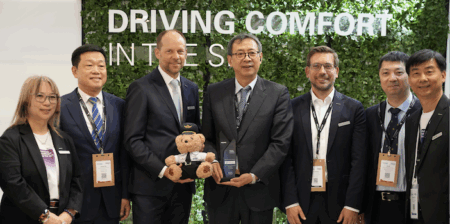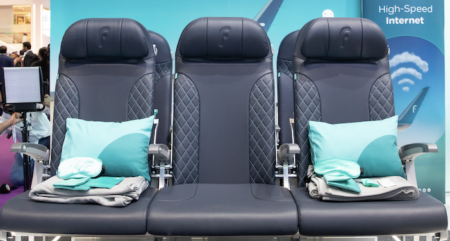We always enjoy a visit to the Recaro stand at Aircraft Interiors Expo. It isn’t generally a stand where you’ll find wild or controversial concepts, or a vision of what flying could be like in 50 years’ time – and that is precisely why we enjoy our visits. Everything you see on the stand, if it is not already in production, is being genuinely considered for production in the near future. This approach may not be great for headlines, but it is a measured approach that has proved effective for delivery deadlines.
However, one announcement at the show is worthy of being headline news: Recaro and Airbus have joined forces to create a joint supplier-furnished equipment (SFE) economy class seat for the A320 – the first SFE economy seat to be offered for this aircraft. The seat, named the 3530Swift (pictured above), is still under development but will be available later this year as a line-fit or retrofit option, and is based on the proven BL3530 model, of which Recaro has already sold more than 240,000 units in orders worth “in the three-digit million Euros”, as CEO of Recaro Aircraft Seating, Dr Mark Hiller, told Aircraft Interiors International at the Expo.
Of course the Swift model may not be of interest to airlines that seek to truly differentiate their cabins, even in the narrow-body sector, but it does have enough options – all predefined, pre-qualified and pre-certified for the A320 – to keep most carriers happy.
There are five options for 3530Swift, which are as follows:
• Basic configuration. The most vanilla choice, with no headrest or lower literature pocket, but it is 18in-wide between the armrests.
• The comfort option. This version does have a headrest and lower literature pocket. We particularly like the neck support function on the six-way adjustable headrest.
• The BYOD (bring your own device) option. This version also includes a simple tablet holder on the seatback, and a band to hold a tablet in place.
• The BYOD Plus option is as above, but with two power outlets per seat triple. However, as this version gives, it also takes away, as the function requires a shroud in the footwell, which eats into foot space.
• Finally, for short-haul or perhaps LCCs, there is a lightweight model. Even the seat pocket is more basic than on the basic version (it is just a few straps), but then it is also lighter overall.
Further options include a choice of dress cover colors and pre-certified plastic parts as part of a customization package. For airlines who wish to fit their own customized covers, as long as an exotic material is not specified, it should not greatly affect delivery time.
As Hiller stated, “The Swift SFE seat is great for airlines – especially smaller airlines – as it will be an efficient choice and they can select predefined, pre-certified options so they have minimum risk, minimum effort, and no milestone meetings as the seat is more or less defined. I think airlines will be happy with the customization options, as we know what the market wants and needs from the BL3530, and we constantly innovate with new features like the tablet holder.
“We are quite confident with this seat. For sure it is not the solution for airlines wanting a very customized seat, but it’s a solution for airlines looking for a very good seat, a good package and an efficient way of implementing seats. It’s also a positive development for Airbus as it supports ramp-up and helps them avoid problems in the supply chain,” he added.
Speaking of supply chain, if the 3530Swift model does prove very popular, will Recaro be able to cope with production? Hiller is confident, stating, “This seat can be produced at four sites – Germany, Poland, China and the USA – so we’re well prepared.”
Above: Recaro was also showing the CL3710 seat featuring a 13.3in IFE monitor. This design, created with Panasonic and Teague, seamlessly integrates the large display with the seatback, to create a carefully considered passenger environment. The design was a finalist in this year’s Crystal Cabin Awards.
Long-haul business seat developments
Recaro was also showing some enhancements to its CL6710 long-haul business class seat, which is due to launch with a European launch customer in Fall 2016 (Recaro is also supplying the economy and premium economy seats for the launch aircraft). These updates include movable armrests to give options for greater shoulder room in bed mode, a retractable divider and an inductive charging pad for cell phones.
A package of monument solutions was also being shown for the CL6710 (pictured below). By working together with partner companies that can complement the seating product, Recaro believes it can support customers in optimizing their layout and stowage efficiency, as well as introducing creative signature features into the cabin. Options include front row monuments that offer comfort features for front-row passengers as well as maximizing stowage space for the crew.
Even better, Recaro has developed a seat ‘app’ for the CL6710 so passengers can control their seat using their cell phone or tablet. Call up the app (downloaded at the time of booking or check-in) and a top layer of predefined options becomes available, including popular seating positions, reading light brightness, ambient lighting colors, etc. If the passenger wishes to further customize the experience, then they can delve deeper into the individual control options, and save those settings for future flights.
This idea is great but nothing new: however, it does have application beyond simply seat control. For example, the connected seat can give airline maintenance crews information on whether any components are broken or require preventative maintenance. And if a fault code does come up, rather than maintenance crew having to wait for the aircraft to arrive before beginning an investigation, they can have the required replacement parts ready for when the aircraft lands. Indeed the system can even say if an actuator is likely to fail in the coming weeks or months so an airline can plan accordingly.
Hiller explained some further benefits of the app for airlines: “Maintenance crews can see fault codes, power consumption, temperature, etc. Cabin crew can see if seats really are in the upright position for TTOL.
“The app can even be used for further development of the seat as we can see how people use the seat, For example, we may find that an actuator is never used, or light, massage or pneumatic functions, etc are not used. Or if they are used, we can see at what part of a flight they are used, and how long for, so we can generate a lot of data and information, which will then help airlines to tailor the product to the needs of passengers.”
Something interesting we found behind the scenes was a range of four concept seat controls for the CL6710. Recaro was using the demonstrator units to garner feedback from airlines about the type of controls that they may like to implement in future seats. One was a series of metal foil buttons in the shape of a seat (shown below right) to clearly indicate which parts they move (similar to that found in a Mercedes); and a button and wheel system (below left) whereby you select the desired function using the buttons, and use the knob to make the adjustment (similar to BMW’s iDrive system).
Another option was a conventional pad showing all functions (below right), but we particularly liked the fourth option. At first glance the controller only had three buttons denoting the most popular seat movement functions of TTOL, relaxing and bed, with the rest of the panel blending into the wood-effect surround. However, touch the wood-like area and the other features are revealed (see below left). This feature is reminiscent of the glovebox button in the first-generation Jaguar XF, but interestingly, Jaguar found that customers couldn’t always find the button and preferred a more traditional chrome button, which was implemented in the next-generation car.
“We are now collecting feedback from airlines and will decide later which options to put on the seat. The CL6710’s options are not defined yet, and these controls are another point of customization,” stated Hiller.
So will the inductive charging pad make it to the options list? Hiller is ready, but he’s not sure if the market is: “Inductive charging is becoming a new standard. In terms of implementation it can be done already, but it depends on market penetration of the technology.”
Talking trends
We also took the opportunity to ask Hiller what trends he has noticed in the seating market. “One is privacy, especially for airlines removing first class, as they need to give business class – or even just some rows in business – more privacy. We are seeing a trend towards business class plus.
“We also think that seat control apps will be on the market in the coming years to make the airline experience more seamless and easier as you can also save your favorite positions. Also, if an airline has different types of seats in its fleet, if all seats can be controlled using the same app, it reduces complexity for customers.”
With the CL5710 business seat for short- and mid-haul rounding off Recaro’s product offer, the only sector left is first class, but Hiller has no intention of entering the fray. “It’s not the plan. For sure what you see with business class now is that the step to first class is not so big anymore, and we see the major market as business class. We see first class disappearing, so our focus is on business and economy seats.”
And premium economy? “It is still a small market, with just a few rows of seats on aircraft, but we are seeing more and more carriers going with premium economy. Some airlines removing first class still want a third class of travel, which is where premium economy comes in,” stated Hiller. “We supply British Airways and SAS with premium economy seats, and now we are supplying Qantas and others.”
We concluded our meeting with Hiller with a view of Recaro’s fiscal outlook, a topic he does not shy away from. “Business is very good. We grew the company by 9% last year, and our long-term goal in the coming years is 10%. We are ramping up to Euro600m turnover per year by 2018,” he stated. “We have a lot of orders, especially for the CL3710, which we think will be the new standard in long-range economy class. We are happy.”
Adam Gavine, April 21, 2015




